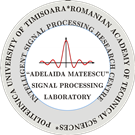|
|
|
Our current and former research projects/contracts are:
-
Study for a monitoring station for EGNOS to support services in Eastern Europe
Due to its geographical location, Romania is an ideal candidate for system performance monitoring at the border of EGNOS service area. Receivers placed in most parts of Romania will be able to track, in addition to EGNOS, also the Russian Federation's System for Differential Corrections and Monitoring (SDCM) and India's GPS Aided GEO Augmented Navigation system (GAGAN).
(more)
|
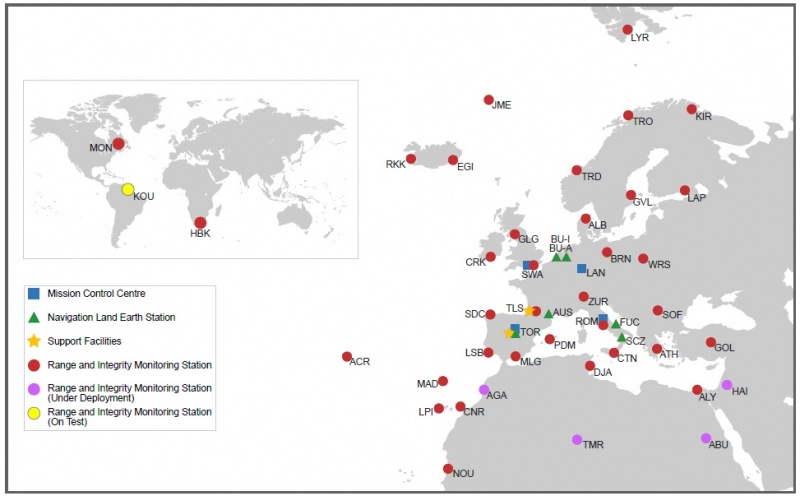
|
-
SY4Sci Synergy Study: Ocean Virtual Laboratory
The project allows oceanography experts to discover the existence and then to handle jointly, in a convenient, flexible and intuitive way, the various co-located Earth Observed (EO) datasets and related model/in-situ datasets over dedicated regions of interest with a different multi facet point of view. The developed tools shall foster the emergence and prototype of new methods and products making use of the complementarity between sensors to study ocean related processes.
(more)
|
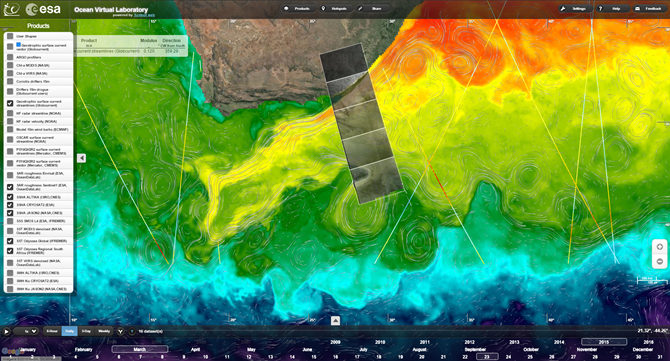
|
-
Quality of Services Improvement for GNSS Localisation in Constraint Environment by Image Fusing Techniques (IMFUSING)
The Line of Sight (LoS) of a satellite could be disrupted by obstacles, reducing the accuracy of the information provided to a
Global Navigation Satellite System (GNSS) receiver. The first objective of the project is to eliminate or weight the signals coming from these satellites.
To simplify the identification of satellites having a direct LoS with the GNSS receiver, this project proposes, as a supplementary sensor, to use a fish eye camera.
The segmentation of the image provided by the fish eye camera permits to identify the satellites that are not on the LoS of the GNSS receiver
(more)
|
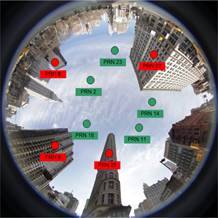
|
-
FP7 ARTRAC, Advanced Radar Tracking and Classification for Enhanced Road Safety (ARTRAC)
ARTRAC aims to develop, test and demonstrate an active vehicle safety system to protect vulnerable road users (VRUs) from vehicles in motion
that is economically viable in the volume vehicle market.
(more)
|
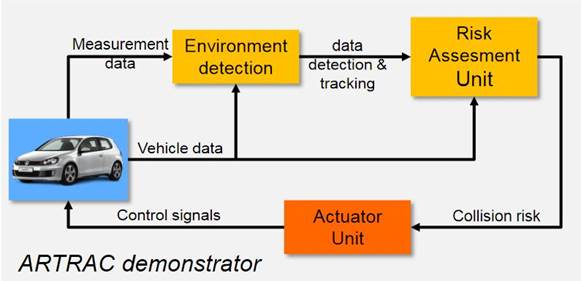
|
-
Texture classification
Stochastic modeling of natural images is subject to a wide range of applications: denoising, filtering, classification, segmentation,
image compression and synthesis. The goal is to have a compact statistical description of the information contained in the image.
The main difficulty in the way of direct statistical modeling of natural images is their high variability. Therefore for natural images, a transform is often
used to obtain a more favorable representation of the statistical model with a lower variability. Designing a good model faces the problem of dimensionality.
The multivariate nature of the problem comes directly from the nature of the data or its projection on higher dimension spaces (multi-level multi-orientation
transform).
(more)
|
-
The use of wavelet theory for decision making
Making decisions is a branch of artificial intelligence that is more and more used in complex applications
like medicine (using a diagnostic, a treatment decision is made), geology (using images of a region, some hypotheses
regarding the underground composition and some decision about extraction are made) or communications
(using information about the functioning of each element of a communication network, some decisions about the resources
allocation are made, for example of the frequency bandwidth). According to Bob Colwell, any machine can have artificial
intelligence. This must be developed on the basis of understanding and imitation of the human brain. The intelligence results
from the action of a large group of specialized neurons that use a world model based on memory to make a continuous series of
predictions of future events. The neural networks of the cortex must be interpreted like a distributed memory of pattern sequences
stoked in an invariant form, ...
(more)
|
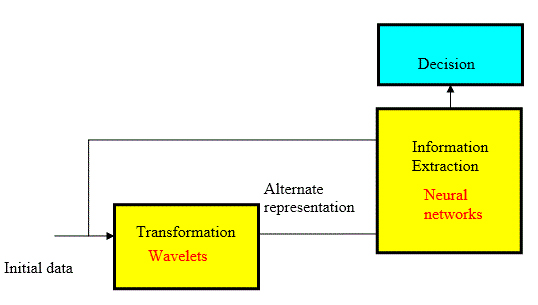
|
-
Denoising
During acquisition and transmission, images are often corrupted by additive noise. The aim of a denoising algorithm
is to reduce the noise level, while preserving the image features. There is a big diversity of estimators used as denoising
systems. One may classify these systems into two categories: those directly applied to the signal and those who use a WT before
processing. In fact, Donoho and Johnstone introduced the word denoising in association with the wavelet theory
(http://www-stat.stanford.edu/~donoho). The multiresolution analysis performed by the WT has been shown to be a powerful tool
to achieve good denoising. In the wavelet domain, the noise is uniformly spread throughout the coefficients, while most
of the useful information is concentrated in the few largest ones (sparsity of the wavelet representation). The corresponding
denoising methods consist of three steps:
1) the computation of the forward WT;
2) the filtering of the wavelet coefficients; and
3) the computation of the IWT of the result obtained...
(more)
|
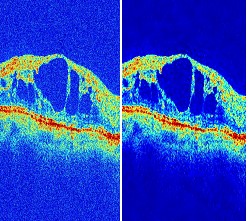
|
-
Tracing Method with Intra and Inter Protocols Correlation.
Tracing Systems for User&Control-Plan Traffic of Packet Core of GPRS-UMTS Networks
The resources of actual tracing tools for Control-Plane and User-Plan traffic are limited and most of them
are crashing under the task of tracing 100% User-Plan traffic. We propose a new tracing system for UP&CP
traffic of Packet Core networks, like GPRS-UMTS networks, in order to verify their functionality. In our
implementation, the total CP traffic and only the selected UP traffic remains under tracing analysis.
All other messages from UP that do not match our filtering system will be discarded ...
(more)
-
Image watermarking in the wavelet domain
In the digital era of Internet, with multimedia products available freely on the web, copying and reproducing works of others
has become extremely easy and the need appeared for copyright protection of digital data, much in the same way as for analog data.
While encryption is a solution to protect the data transmitted from the seller to the buyer,
watermarking has been proposed as a solution to ensure the copyright protection.
Digital watermarking means embedding of information (i.e. a watermark) in media signals
without making perceptible changes. There is a tradeoff among conflicting requirements: Imperceptibility, Robustness & security
and Capacity. Common image watermarking techniques work in the spatial domain or frequency domain.
We have proposed...
(more)
|
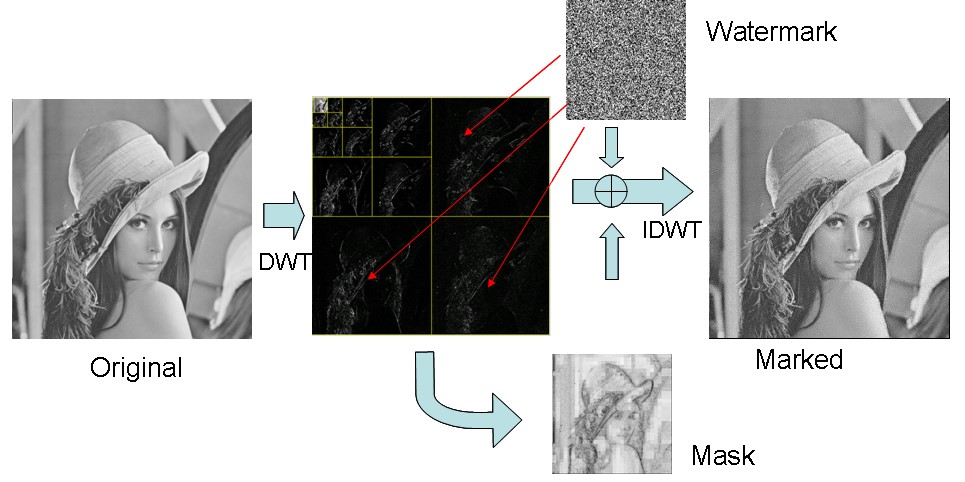
|
- Contributions to the application of Kalman filtering in communications
Polynomial phase signals (PPS) are frequently used in many signal processing applications such as in radar, sonar,
laser velocimetry or telecommunications. They are non-stationary signals with a fast-varying instantaneous frequency.
The parameters' estimation of the PPS signals affected by additive Gaussian noise has received considerable interest in
signal processing literature and several methods, formulated as linear system identification problems, have been used to
solve the problem. We investigate an estimation method based on an approximate linear state space representation of the
polynomial phase signal using an Extended Kalman Filtering...
(more)
|
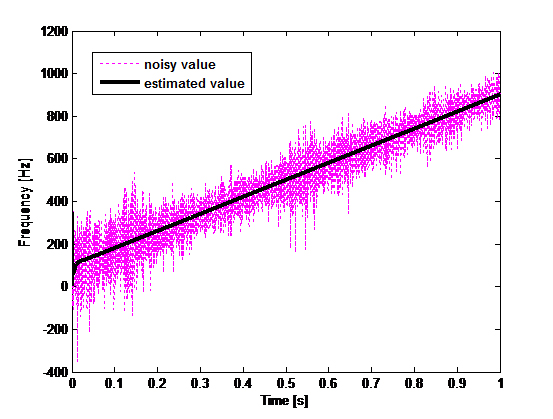
|
- Turbocodes
The fading phenomenon occurs in radio transmission channels. It is due to the presence of multipath that varies during the
transmission. We analyze the performance in terms of Bit Error Rate and Frame Error Rate of a (multi-binary) turbo-coded system
over frequency-nonselective fading multipath channels...
(more)
|

|
-
Radio transmission improvement with wavelets
Despite their popularity in signal processing, few wavelets applications were found for data transmission. Most of the data
transmission systems nowadays use Orthogonal Frequency Division Multiplexing (OFDM) or some versions of it: WiFi (IEEE 802.11),
WiMAX (IEEE 802.16), LTE (3GPP rel.8) or ADSL. The idea that gathers wavelet theory and data transmission is to use wavelet signals
as carriers in a multi-carrier communication. Recent research has shown that, by associating the multi-carrier concept and the
wavelet signals, some of the OFDM's classical drawbacks can be counteracted. Thus, some wavelet based multi-carrier schemes may
provide significant out-of-band side-lobes rejection, by comparison to OFDM. Furthermore, WOFDM proved to be more robust to the time
variability of the radio channel...
(more)
|
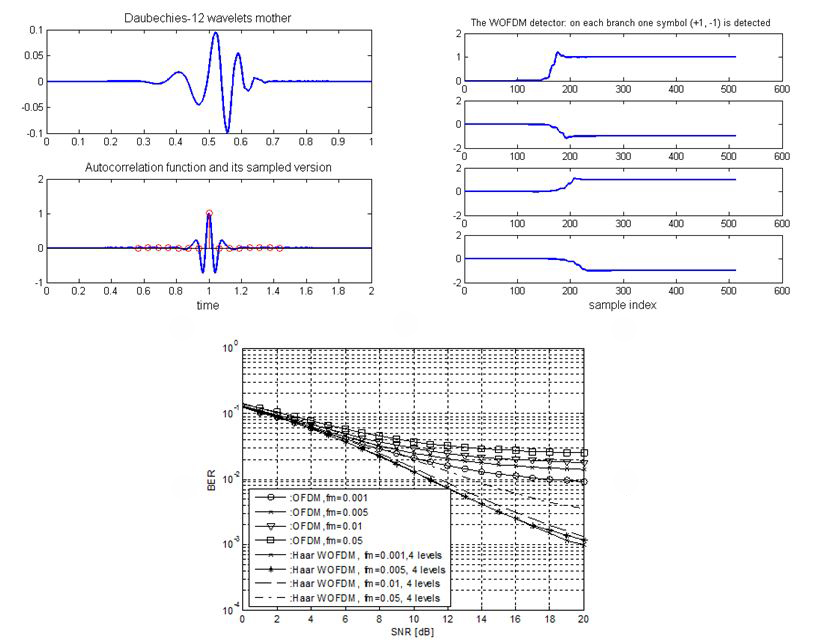
|
Diagnosis And Prognosis Of Urological Diseases using Neural Networks
The deseases diagnosis and prognosis are usually realized by analyses and processing of clinical information. When the volume and
the variety of the information become too demanding for the clinician, the need for supportive statistical prediction methods emerges.
When the classical methods, like statistical modeling, are failing, due to the computational complexity and to the long processing time,
the neural networks (NN) could offer effective solutions, being able to perform real-time prediction of the deseases diagnosis and
prognosis of a particular patient. We have developed and validated a neural integrated set of programs, in an adequate programming
medium, capable to offer solutions to some urological problems. The inputs are variables carefully selected, obtained from the real
situations and readily comparable with the real, functional, clinical models... (more)
Network Traffic Anomaly Detection Based on Signal Processing Techniques
Intrusion detection and network security has become and important problem in today's world. The Internet, the emergence of a
variety of wireless networks, the mobility of network hosts along with the vulnerability of present-day software and protocols have
a major impact regarding the evolution of network-based attacks. Network intrusions are carried out in various forms: virus, spamming,
worms, malware, privilege escalation, unauthorized logins, access to sensitive information, attacks against vulnerable services,
injecting unwanted packets into the target networks. As a consequence, this insecure environment has lead to the development of
network intrusion detection systems (IDS).
Signal processing techniques have attracted a lot of attention recently in the networking security technology, because of their
capability of detecting novel intrusions or attacks ...
(more)
|
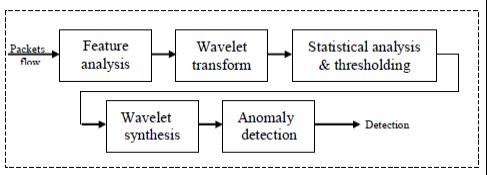
General architecture of the IDS
|
-
Instantaneous Frequency Estimation
Any time-frequency representation of a signal contains crucial information on the characteristics of the signal. We deal with the
estimation of the instantaneous frequency of signals corrupted by additive noise based on the use a time-frequency representation
of the analyzed signal, followed by a morphological treatment of the image obtained. Any time-frequency representation of an acquired
signal is concentrated around the instantaneous frequency law of its useful component (the projection of the ridges of the
time-frequency representation on the time-frequency plane) and realizes the diffusion of its noise component. So, extracting the ridges
of the time-frequency representation, the instantaneous frequency of its useful component can be estimated...
(more)
|
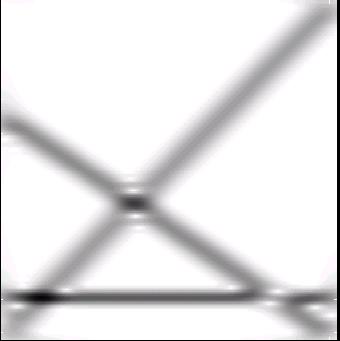
|
-
Nonlinear Signal Processing Techniques
The identification and compensation of unwanted nonlinearities are required in many telecommunications systems in order to improve the system performances.
We use Volterra models as well as neural network equalizars to identificate and compensate unwanted nonlinearities in telecommunications systems, in order to improve the system perfomance.
Volterra filter is widely used to model unwanted nonlinearities and provides also compensations techniques.
The multiple quadrature amplitude modulated (M-QAM) signals, more efficient in transmission from the spectral point of view, are severely affected by the nonlinear distortions, and to compensate
these unwanted distortions neural networks equalizers for complex signals have been developed ...
(more)
|
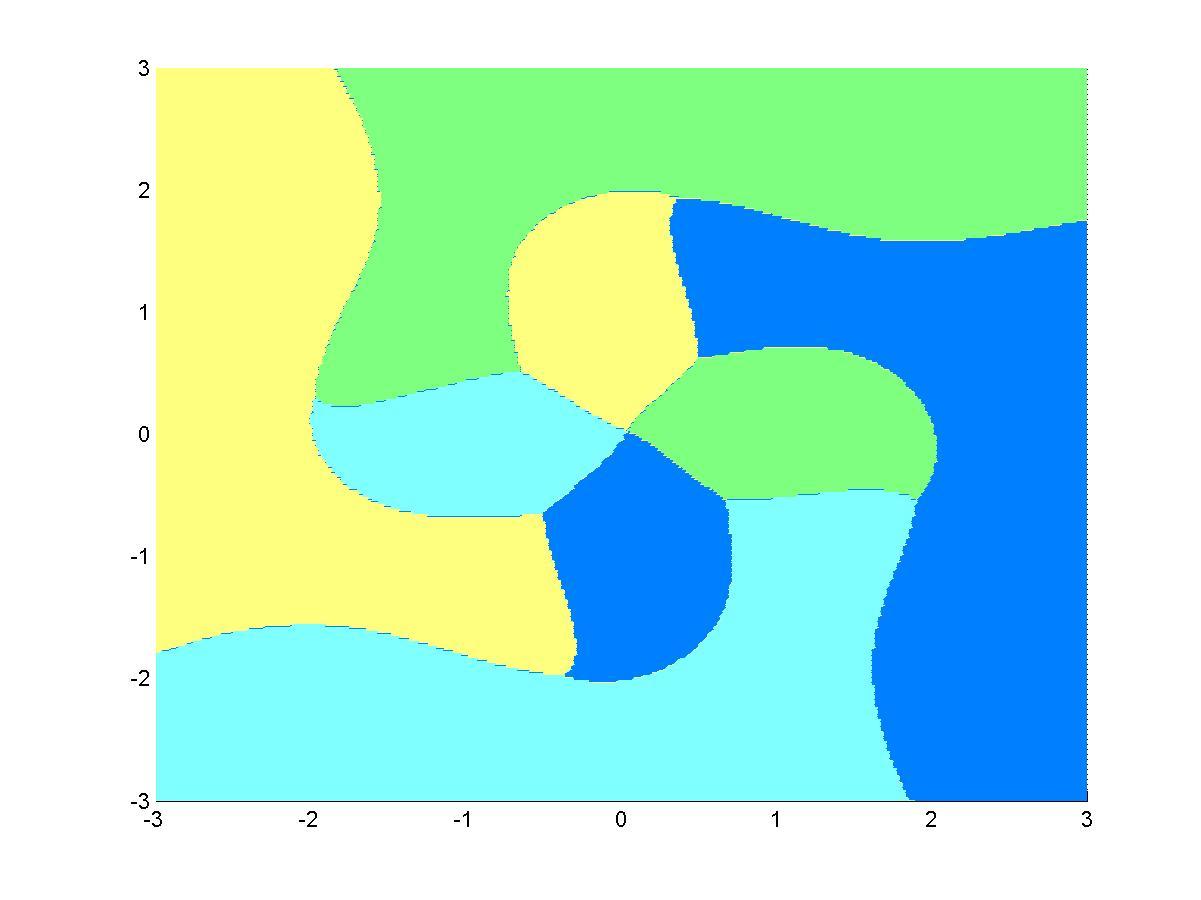
Decision regions of an RBF-NN complex equalizer in a complex data space,
which have strong nonlinear decisions
boundaries
|
|
|
|
